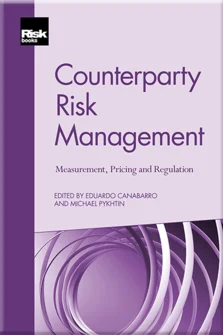The Non-Internal Model Method for Counterparty Credit Risk
The Basel III Enhancements to Counterparty Risk Capital Charges
The Regulation of Counterparty Risk in Over-the-Counter Derivatives Markets
The Non-Internal Model Method for Counterparty Credit Risk
On Credit Valuation Adjustments and Regulatory Capital
American Monte Carlo: A Practitioner Approach
Best Market Practice for Calculation and Reporting of Wrong-Way Risk
Central Counterparty Risk
CVA Risk Management Post-Crisis
Re-Thinking CVA: Valuations, Counterparty Credit Risk and Model Risk
Should Derivatives Dealers Make A Funding Value Adjustment?
Adjoint Algorithmic Differentiation: Real-Time Counterparty Credit Risk Management in Monte Carlo Simulations
Stress Test of Counterparty Risks and Dynamic Hedging of the CVA
Dynamic Stress Testing of Counterparty Default Risk
Collateral: Modelling, Pricing and Optimisation

Basel II (Basel Committee on Banking Supervision 2006) provides three methods for calculating exposure at default (EAD) for counterparty credit risk (CCR). Banks that use advanced risk management and exposure modelling practices can apply to their national supervisors for permission to use the internal model method (IMM) for determining EAD. Unless a bank has supervisory permission to use the IMM (we shall call such banks IMM banks), it must use one of the two non-model methods: the Current Exposure Method (CEM) or the Standardised Method (SM). Some jurisdictions (including the US) do not permit the SM and only allow the CEM as a single non-model method. In jurisdictions that allow both methods, most non-IMM banks have chosen to use the CEM.
Basel III has introduced numerous enhancements to treatment of CCR (for details, see Chapter 1 in this volume). In particular, the area of applicability of the non-model methods has expanded. Under Basel III, all banks must use a non-internal method for calculating minimum capital requirements for exposure to central counterparties (CCPs)11See Basel Committee on Banking Supervision (2013c). and for calculating leverage ratio22See Basel
Copyright Infopro Digital Limited. All rights reserved.
As outlined in our terms and conditions, https://www.infopro-digital.com/terms-and-conditions/subscriptions/ (point 2.4), printing is limited to a single copy.
If you would like to purchase additional rights please email info@risk.net
Copyright Infopro Digital Limited. All rights reserved.
You may share this content using our article tools. As outlined in our terms and conditions, https://www.infopro-digital.com/terms-and-conditions/subscriptions/ (clause 2.4), an Authorised User may only make one copy of the materials for their own personal use. You must also comply with the restrictions in clause 2.5.
If you would like to purchase additional rights please email info@risk.net











